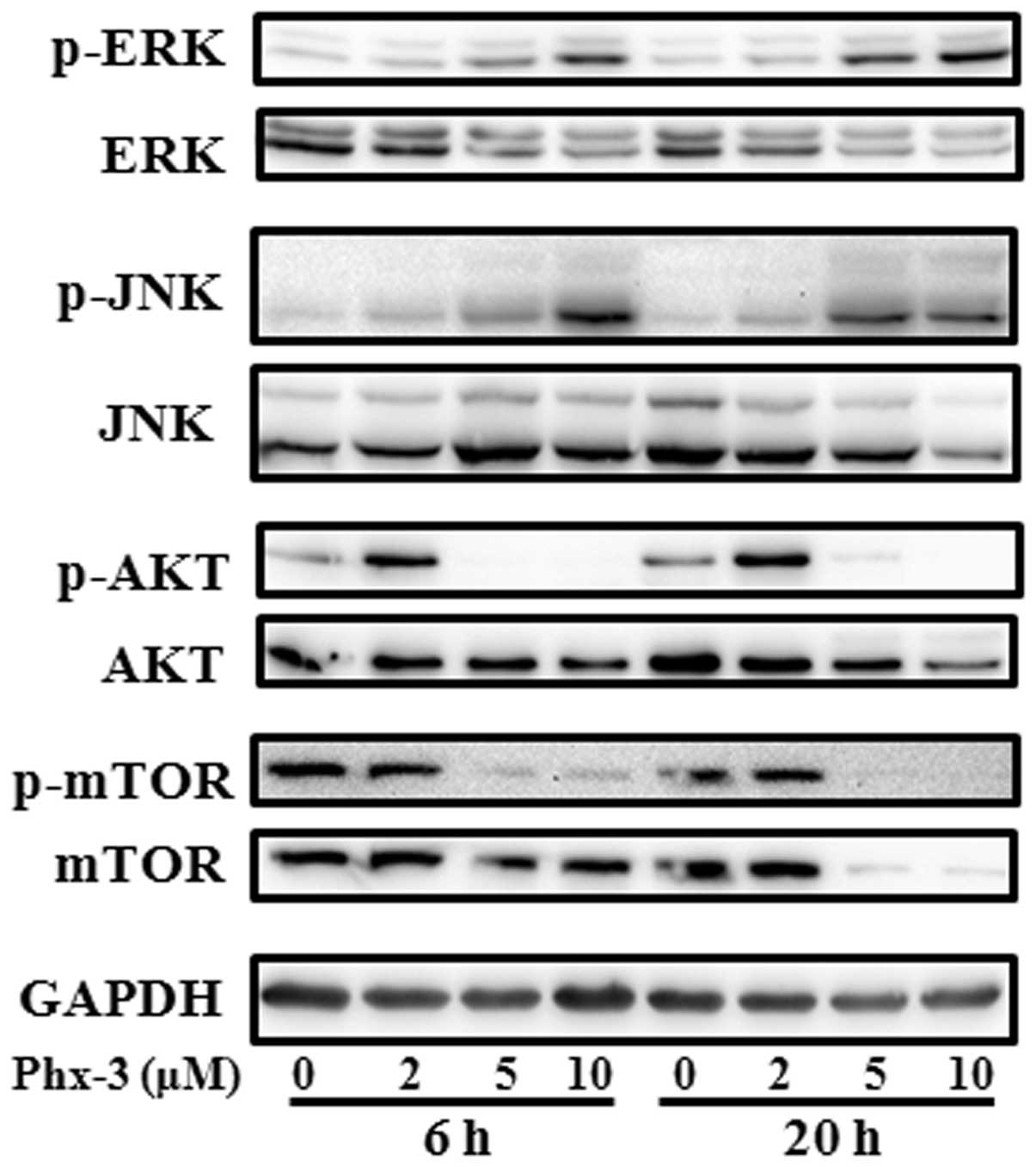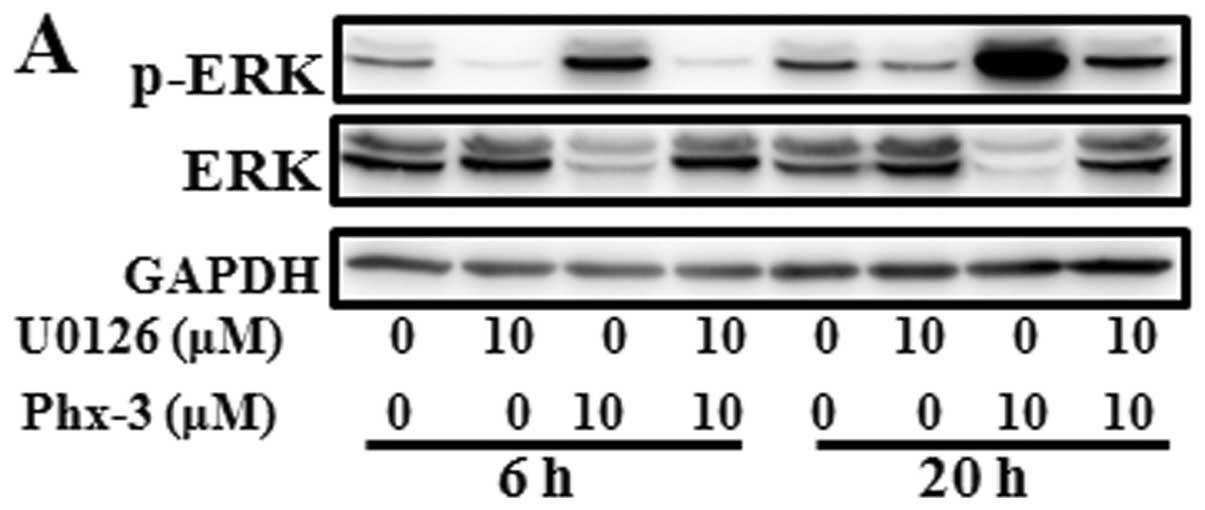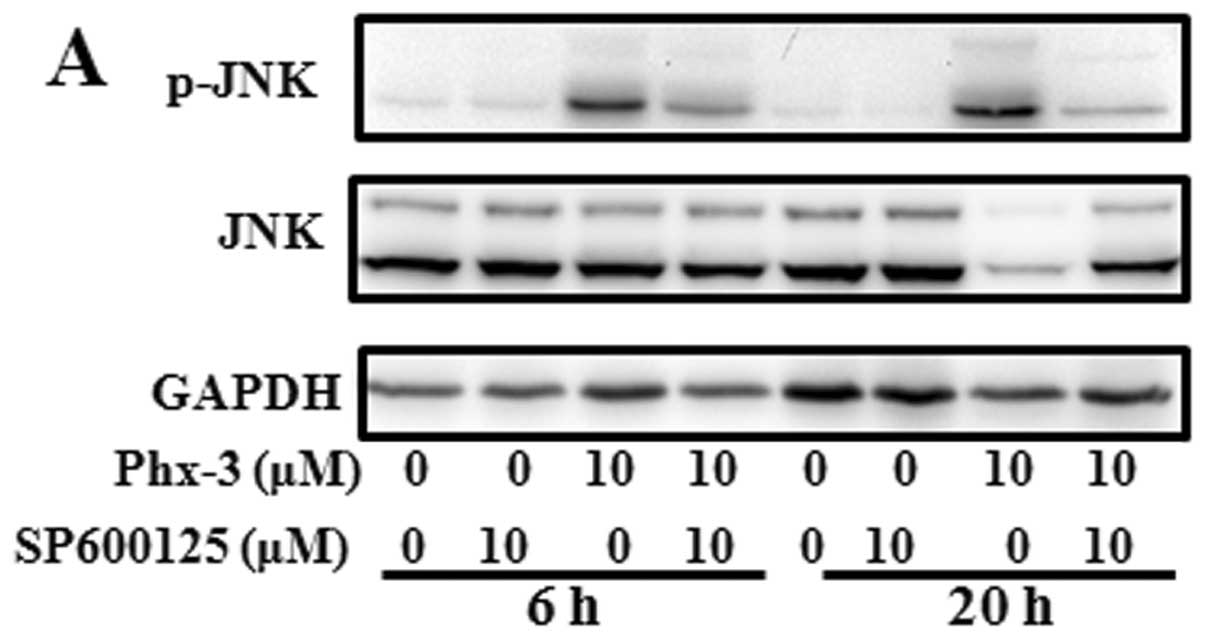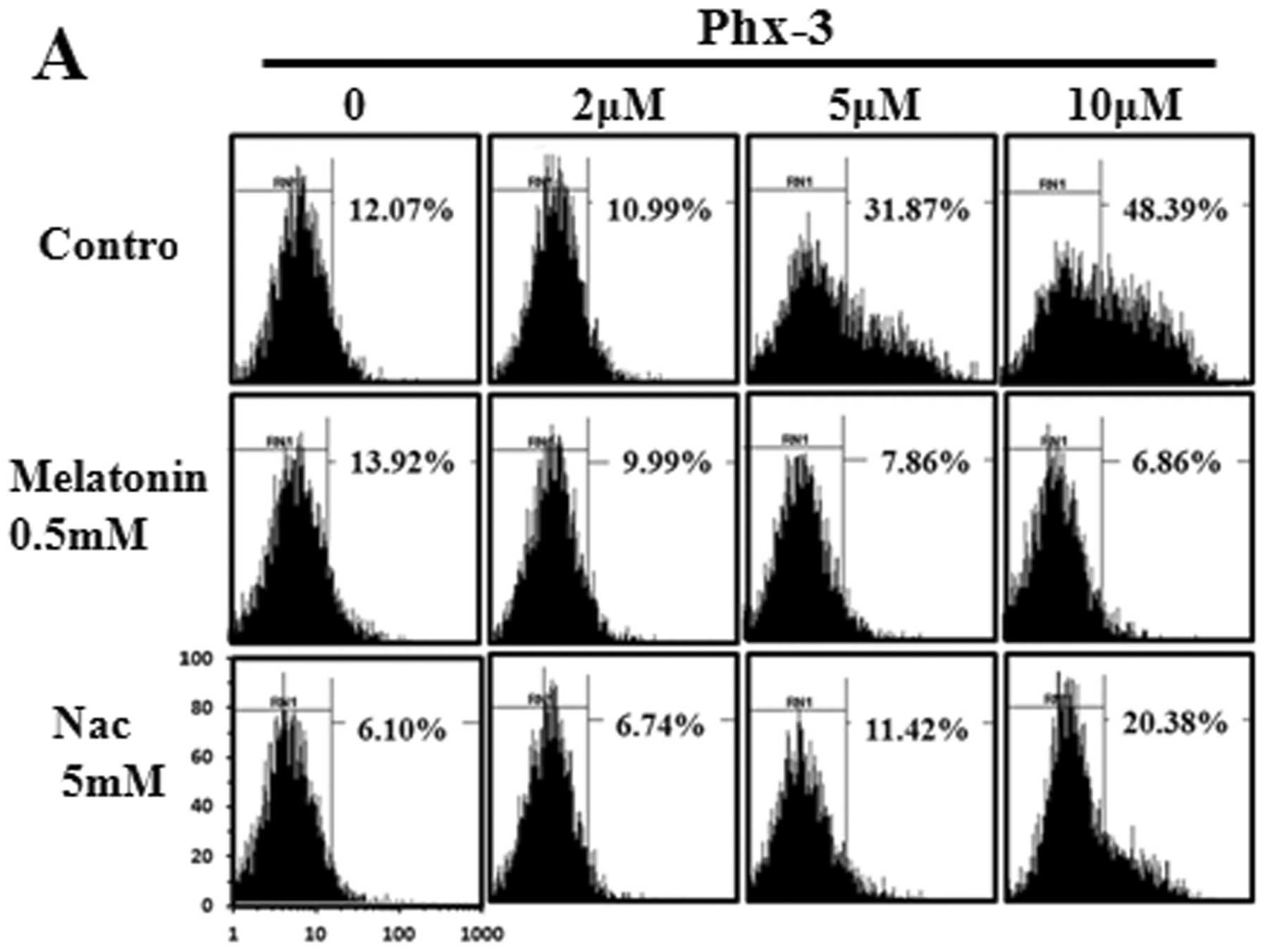|
1.
|
Bidros DS and Vogelbaum MA: Novel drug
delivery strategies in neuro-oncology. Neurotherapeutics.
6:539–546. 2009. View Article : Google Scholar : PubMed/NCBI
|
|
2.
|
Tomoda A, Arai S, Ishida R, Shimamoto T
and Ohyashiki K: An improved method for the rapid preparation of
2-amino-4,4·-di-hydro-4,7-dimethyl-3Hphenoxazine-3-one, a novel
antitumor agent. Bioorg Med Chem Lett. 11:1057–1058.
2001.PubMed/NCBI
|
|
3.
|
Shimizu S, Suzuki M, Tomoda A, Arai S,
Taguchi H, Hanawa T and Kamiya S: Phenoxazine compounds produced by
the reactions with bovine hemoglobin show antimicrobial activity
against non-tuberculosis mycobacteria. Tohoku J Exp Med. 203:47–52.
2004. View Article : Google Scholar
|
|
4.
|
Shimamoto T, Tomoda A, Ishida R and
Ohyashiki K: Antitumor effects of a novel phenoxazine derivative on
human leukemia cell lines in vitro and in vivo. Clin Cancer Res.
7:704–708. 2001.PubMed/NCBI
|
|
5.
|
Shirato K, Imaizumi K, Miyazawa K,
Takasaki A, Mizuguchi J, Che XF, Akiyama S and Tomoda A: Apoptosis
induction preceded by mitochondrial depolarization in multiple
myeloma cell line U266 by 2-aminophenoxazine-3-one. Biol Pharm
Bull. 31:62–67. 2008. View Article : Google Scholar : PubMed/NCBI
|
|
6.
|
Shirato K, Imaizumi K, Abe A and Tomoda A:
Phenoxazine derivatives induce caspase-independent cell death in
human glioblastoma cell lines, A-172 and U-251MG. Oncol Rep.
17:201–208. 2007.PubMed/NCBI
|
|
7.
|
Miyano-Kurosaki N, Kurosaki K, Hayaashi M,
Takaku H, Hayafune M, Shrato K, Kasuga T, Endo T and Tomoda A:
2-Aminophenoxazine-3-one suppresses the growth of mouse malignant
melanoma B16 cells transplanted into C57BL/6Cr Slc mice. Biol Pharm
Bull. 29:2197–2201. 2006. View Article : Google Scholar : PubMed/NCBI
|
|
8.
|
Che XF, Zheng CL, Akiyama S and Tomoda A:
2-Amino phenoxazine-3-one and
2-amino-4,4α-dihydro-4α,7-dimethyl-3H-phenoxazine-3-one cause
cellular apoptosis by reducing higher intracellular pH in cancer
cells. Proc Jpn Acad Ser B Phys Biol Sci. 87:199–213. 2011.
|
|
9.
|
Takasaki A, Hanyu H, Iwamoto T, Shirato K,
Izumi R, Toyota H, Izuguchi J, Miyazawa K and Tomoda A:
Mitochondrial depolarization and apoptosis associated with
sustained activation of c-jun-N-terminal kinasein the human
multiple myeloma cell line U266 induced by
2-aminophenoxazine-3-one. Mol Med Rep. 2:199–203. 2009.PubMed/NCBI
|
|
10.
|
Zheng CL, Che XF, Akiyama S, Miyazawa K
and Tomoda A: 2-Aminophenoxazine-3-one induces cellular apoptosis
by causing rapid intracellular acidification and generating
reactive oxygen species in human lung adenocarcinoma cells. Int J
Oncol. 36:641–650. 2010.
|
|
11.
|
Azuine MA, Tokuda H, Takayasu J, Enjyo F,
Mukainaka T, Konoshima T, Nishino H and Kapadia GJ: Cancer
chemopreventive effect of phenothiazines and related
tri-heterocyclic analogues in the
12-O-tetradecanoylphorbol-13-acetate promoted Epstein-Barr virus
early antigen activation and the mouse skin two-stage
carcinogenesis models. Pharmacol Res. 49:161–169. 2004. View Article : Google Scholar
|
|
12.
|
Nakada M, Kita D, Watanabe T, Hayashi Y,
Teng L, Pyko IV and Hamada J: Aberrant signaling pathways in
glioma. Cancers. 3:3242–3278. 2011. View Article : Google Scholar : PubMed/NCBI
|
|
13.
|
Soni D, King JA, Kaye AH and Hovens CM:
Genetics of glioblastoma multiforme: mitogenic signaling and cell
cycle pathways converge. J Clin Neurosci. 12:1–5. 2005. View Article : Google Scholar : PubMed/NCBI
|
|
14.
|
Los M, Maddika S, Erb B and
Schulze-Osthoff K: Switching Akt: from survival signaling to deadly
response. Bioessays. 31:492–495. 2009. View Article : Google Scholar : PubMed/NCBI
|
|
15.
|
Pearson G, Robinson F, Beers Gibson T, Xu
BE, Karandikar M, Berman K and Cobb MH: Mitogen-activated protein
(MAP) kinase pathways: regulation and physiological functions.
Endocr Rev. 22:153–183. 2001.PubMed/NCBI
|
|
16.
|
Davis RJ: Signal transduction by the JNK
group of MAP kinases. Cell. 103:239–252. 2000. View Article : Google Scholar : PubMed/NCBI
|
|
17.
|
Nakachi T, Tabuchi T, Takasaki A, Arai S,
Miyazawa K and Tomoda A: Anticancer activity of phenoxazines
produced by bovine erythrocytes on colon cancer cells. Oncol Rep.
23:1517–1522. 2010.PubMed/NCBI
|
|
18.
|
Kawaguchi T, Miyazawa K, Moriya S, Ohtomo
T, Che XF, Naito M, Itoh M and Tomoda A: Combined treatment with
bortezomib plus bafilomycin A1 enhances the cytocidal effect and
induces endoplasmic reticulum stress in U266 myeloma cells:
crosstalk among proteasome, autophagy-lysosome and ER stress. Int J
Oncol. 38:643–654. 2011.
|
|
19.
|
Nohl H, Gille L and Staniek K:
Intracellular generation of reactive oxygen species by
mitochondria. Biochem Pharmacol. 69:719–723. 2005. View Article : Google Scholar : PubMed/NCBI
|
|
20.
|
Gogvadze V, Orrenius S and Zhivotovsky B:
Mitochondria as targets for cancer chemotherapy. Semin Cancer Biol.
19:57–66. 2009. View Article : Google Scholar : PubMed/NCBI
|
|
21.
|
Maundrell K, Antonsson B, Magnenat E,
Camps M, Muda M, Chabert C, Gillieron C, Boschert U, Vial-Knecht E,
Martinou JC and Arkinstall S: Bcl-2 undergoes phosphorylation by
c-Jun N-terminal kinase/stress-activated protein kinases in the
presence of the constitutively active GTP-binding protein Rac1. J
Biol Chem. 272:25238–25242. 1997. View Article : Google Scholar
|
|
22.
|
Basu A and Haldar S: Identification of a
novel Bcl-xL phospho rylation site regulating the sensitivity of
taxol- or 2-methoxyestradiol-induced apoptosis. FEBS Lett.
538:41–47. 2003. View Article : Google Scholar : PubMed/NCBI
|
|
23.
|
Fulda S, Gorman AM, Hori O and Samali A:
Cellular stress responses: cell survival and cell death. Int J Cell
Biol. 2010:2140742010. View Article : Google Scholar : PubMed/NCBI
|
|
24.
|
Trachootham D, Lu W, Ogasawara MA, Valle
NR and Huang P: Redox regulation of cell survival. Antioxid Redox
Signal. 10:1343–1374. 2008. View Article : Google Scholar : PubMed/NCBI
|
|
25.
|
Feligioni M, Brambilla E, Camassa A, Sclip
A, Arnaboldi A, Morelli F, Antoniou X and Borsello T: Crosstalk
between JNK and SUMO signaling pathways: deSUMOylation is
protective against H2O2-induced cell injury.
PLoS One. 6:e281852011. View Article : Google Scholar : PubMed/NCBI
|
|
26.
|
Conde de la Rosa L, Schoemaker MH, Vrenken
TE, Buist-Homan M, Havinga R, Jansen PL and Moshage H: Superoxide
anions and hydrogen peroxide induce hepatocyte death by different
mechanisms: involvement of JNK and ERK MAP kinases. J Hepatol.
44:918–929. 2006.PubMed/NCBI
|
|
27.
|
Matos TJ, Duarte CB, Goncalo M and Lopes
MC: Role of oxidative stress in ERK and p38 MAPK activation induced
by the chemical sensitizer DNFB in a fetal skin dendritic cell
line. Immunol Cell Biol. 83:607–614. 2005. View Article : Google Scholar : PubMed/NCBI
|
|
28.
|
Tobiume K, Matsuzawa A, Takahashi T,
Nishitoh H, Morita K, Takeda K, Minowa O, Miyazono K, Noda T and
Ichijo H: ASK1 is required for sustained activations of JNK/p38 MAP
kinases and apoptosis. EMBO Rep. 2:222–228. 2001. View Article : Google Scholar : PubMed/NCBI
|
|
29.
|
Song JJ, Rhee JG, Suntharalingam M, Walsh
SA, Spitz DR and Lee YJ: Role of glutaredoxin in metabolic
oxidative stress: glutaredoxin as a sensor of oxidative stress
mediated by H2O2. J Biol Chem.
277:46566–46575. 2002. View Article : Google Scholar : PubMed/NCBI
|
|
30.
|
Yoshizumi M, Abe J, Haendeler J, Huang Q
and Berk BC: Src and Cas mediate JNK activation but not ERK1/2 and
p38 kinases by reactive oxygen species. J Biol Chem.
275:11706–11712. 2000. View Article : Google Scholar : PubMed/NCBI
|
|
31.
|
Wang T, Arifoglu P, Ronai Z and Tew KD:
Glutathione S-transferase P1-1 (GSTP1-1) inhibits c-Jun N-terminal
kinase (JNK1) signaling through interaction with the C terminus. J
Biol Chem. 276:20999–21003. 2001. View Article : Google Scholar : PubMed/NCBI
|
|
32.
|
Sinha D, Bannergee S, Schwartz JH,
Lieberthal W and Levine JS: Inhibition of ligand-independent ERK1/2
activity in kidney proximal tubular cells deprived of soluble
survival factors upregulates Akt and prevents apoptosis. J Biol
Chem. 279:10962–10972. 2004. View Article : Google Scholar
|


















